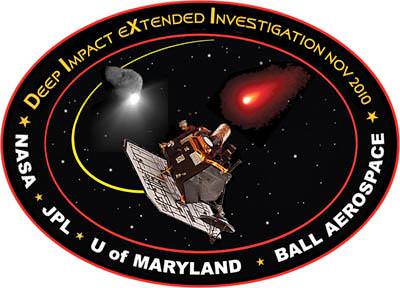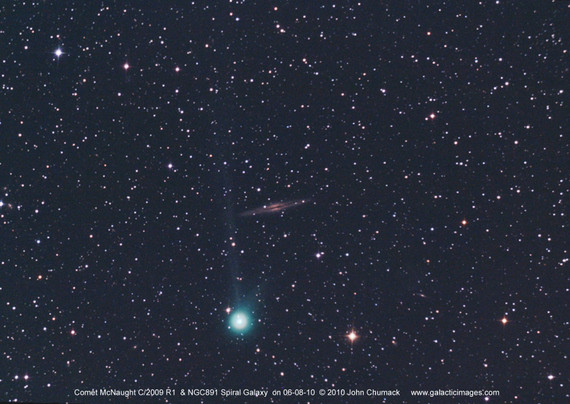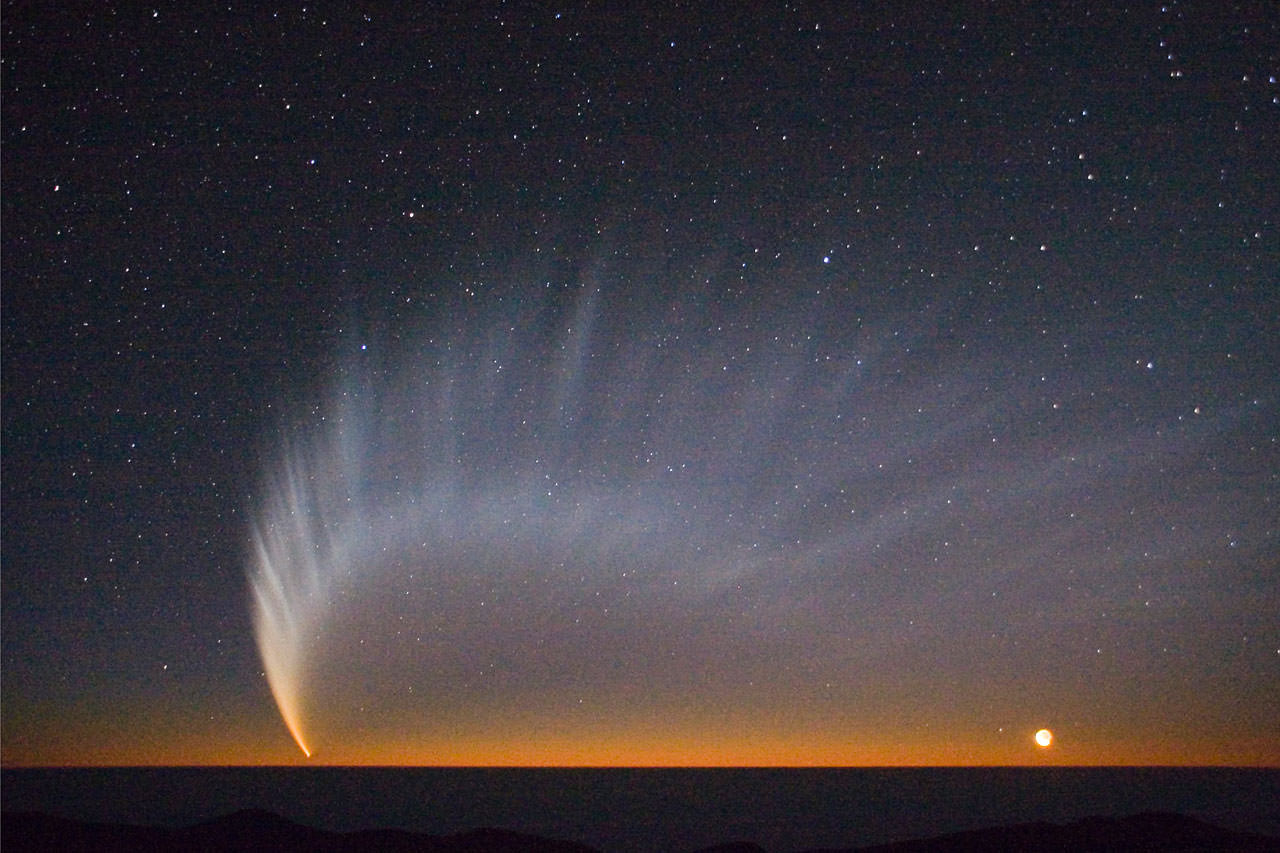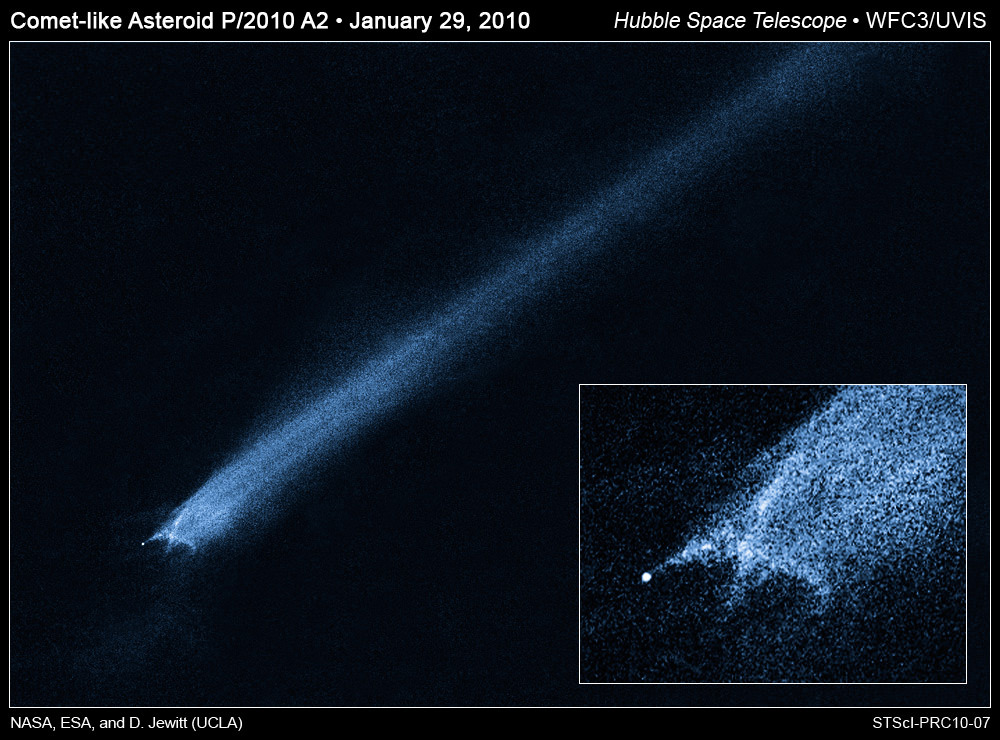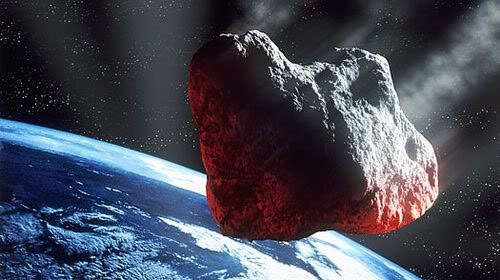Watch live coverage of the EPOXI mission’s close flyby of Comet Hartley 2. Live coverage begins on November 4, 2010 at 9:30 a.m. EDT (6:30 a.m. PDT) from mission control at the Jet Propulsion Laboratory. You can watch NASA TV’s Media Channel online at this link, (and make sure you click on the “Media Channel” tab on the right side of the “tv” screen). You can also watch on JPL’s UStream channel online. Coverage includes closest approach, an educational segment, and the return of close-approach images. Emily Lakdawalla of the Planetary Society Blog has posted a very detailed timeline of the encounter.
Continue reading “Watch Live Coverage of EPOXI’s Hartley 2 Encounter on Nov. 4”
A Comet that Gives Twice?
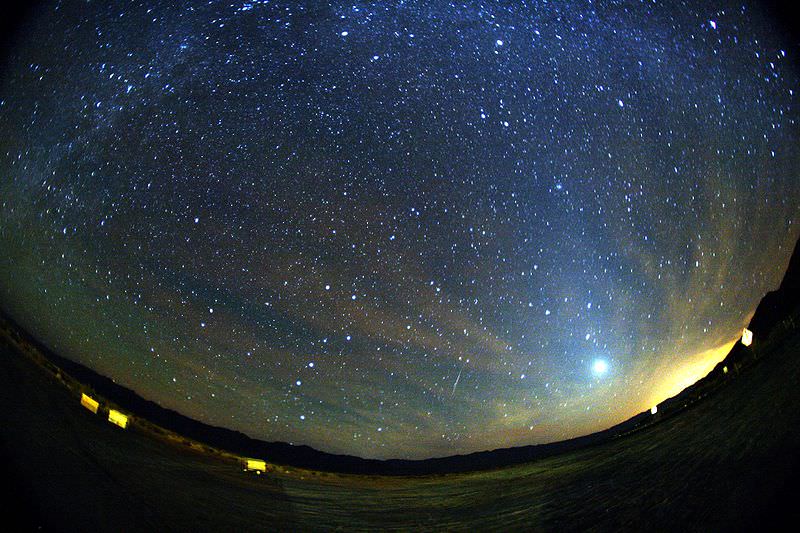
[/caption]
While historically, meteor showers were portents of ill omens, we know today that they are the remnants of ejecta from comets entering our atmosphere. Many showers have had their parent comets identified. But a new study is suggesting that two meteor showers, the December Monocerotids and the November Orionids, may share the same parent.
The possibility of a single comet providing multiple showers isn’t too difficult to imagine. Since comets orbit the Sun in elliptical paths there are two potential points the path can intersect Earth’s orbit: Once on the way in and once on the way out. The trouble is that comets don’t tend to orbit directly in the ecliptic plane (defined by the plane on which the Earth orbits the Sun). Thus, comets only puncture through this plane at points known as “nodes”. As a body passes from the upper half to the lower (where upper and lower are the halves defined by Earth’s north and south poles respectively) this point of intersection of the orbit with the ecliptic plane is known as the descending node. When it heads back up, this is the ascending node. If both nodes happen to lie near enough to Earth’s orbital path, the potential for two meteor showers exists. Another possibility is that orbital evolution cause the nodes to change their position and, over time, crossed Earth’s orbit at two different points.
In principle, identifying a parent comet for two showers is much simpler with the first method. In that instance, the comet still orbits in the same path (or near enough) to be conclusively identified as the progenitor. If such an instance were to arise due to orbital evolution, the case must be much more indirect since interactions with planets, even at fairly large distances, can induce large uncertainties in the orbital history.
The December Monocerotids have been associated with a comet known as C/1917 F1 Mellish. Unfortunately for the researchers, the current orbital characteristics of the comet did not feature nodes in Earth’s orbit and did not match the November Orionids. Thus, to establish a connection between the two meteor streams, the team of astronomers from Comenius University in Slovakia, looked at the characteristics of the showers. In order to track these characteristics, the team utilized a publicly available database of meteor recordings from SonotaCo which uses webcams to capture video of meteors and then compute the orbital characteristics of the debris. However, the two showers did share suspiciously similar distributions of sizes (and thus brightnesses) of meteors as well as the velocity and less so, but still notable, the eccentricity.
This led the team to suspect that the node had evolved across Earth’s orbit sweeping by once in the past to create the stream of debris that forms the November shower, and more recently, crossed our orbit to create the December shower. If this hypothesis were correct, the team expected to also find subtle differences hinting that the November shower was older. Sure enough, the November Orionids show a larger dispersion of velocities than that of the December shower.
In the future, the team plans to revise the orbital characteristics of the parent comet. While they were able to show that the precession of the orbit would allow for the situation described, it was only one of a number of possible solutions. Thus, refining the knowledge of the orbit, perhaps from archival photographic plates, would allow the team to better constrain the path and determine the orbital history sufficiently to reinforce or refute their scenario.
Spacecraft to Make Final Flyby of Earth
[/caption]
The re-purposed Deep Impact spacecraft will make one final flyby of Earth on Sunday June 27, 2010, getting a gravity assist to help propel the spacecraft towards a meetup with comet Hartley 2 this fall. The spacecraft bus that brought the Deep Impact “impactor” to comet Tempel 1 in July of 2005 has been put back to work double time where two new missions share the same spacecraft. This is the fifth time this spacecraft has flown by Earth, and at the time of closest approach on Sunday, it will be about 30,400 kilometers (18,900 miles) above the South Atlantic.
“The speed and orbital track of the spacecraft can be changed by changing aspects of its flyby of Earth, such as how close it comes to the planet,” said University of Maryland astronomer Michael A’Hearn, principal investigator for both the new EPOXI mission and its predecessor mission, Deep Impact.
The combined operation EPOXI is a combo-acronym of the two separate missions. The Deep Impact Extended Investigation (DIXI) of comets will observe comet 103P/Hartley 2 during a close flyby in November 2010. The other half of the dynamic duo, called the Extrasolar Planet Observation and Characterization (EPOCh) which is observing stars already known to have transiting giant planets.
“There is always some gravity boost at a flyby and in some cases, like this one, it is the main reason for a flyby. The last Earth flyby was used primarily to change the tilt of the spacecraft’s orbit to match that of comet Hartley 2, and we are using Sunday’s flyby to also change the shape of the orbit to get us to the comet,” said A’Hearn.
The Deep Impact mission smashed a companion probe into comet Tempel 1 on July 4, 2005 to reveal the inner material of a comet.
“Earth is a great place to pick up orbital velocity,” said Tim Larson, the EPOXI project manager from NASA’s Jet Propulsion Laboratory in Pasadena, Calif. “This flyby will give our spacecraft a 1.5-kilometer-per-second [3,470 mph] boost, setting us up to get up close and personal with comet Hartley 2.”
During a previous flyby of Earth, the mission team has used the spacecraft’s instruments to find evidence of water on the Moon and to study light reflected from Earth as a template that scientists eventually may be able be use to identify Earth-like planets around other stars.
Source: University of Maryland
Many Famous Comets May be Visitors from Other Solar Systems
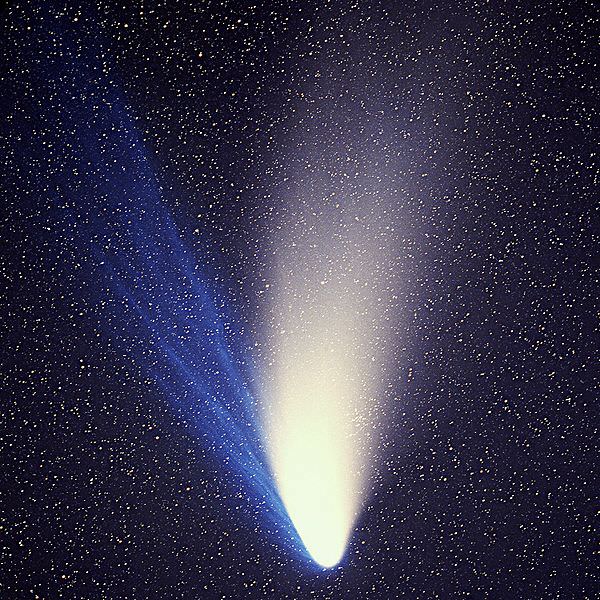
[/caption]
Most comets are thought to have originated great distances away, traveling to the inner solar system from the Oort Cloud. But new computer simulations show that many comets – including some famous ones – came from even farther: they may have been born in other solar systems. Many of the most well known comets, including the Hale Bopp Comet (above), Halley, and, most recently, McNaught, may have formed around other stars and then were gravitationally captured by our Sun when it was still in its birth cluster. This new finding solves the mystery of how the Oort cloud formed and why it is so heavily populated with comets.
Comets are believed to be leftovers from the formation of the solar system. They are observed to come to the solar system from all directions, so astronomers have thought the comet’s origin was from the Oort Cloud, a giant sphere surrounding the solar system. Some comets travel over 100,000 AU, in a huge orbit around the sun.
But comets may have formed around other stars in the cluster where the sun was born and been captured gravitationally by our sun.
Dr. Hal Levison from the Southwest Research Insitutue, along with Dr. Martin Duncan from Queen’s University, Kingston, Canada, Dr. Ramon Brasser, Observatoire de la Côte d’Azur, France and Dr. David Kaufmann (SwRI) used computer simulations to show that the Sun may have captured small icy bodies from its sibling stars while still in its star-forming nursery cluster.
The researchers investigated what fraction of comets might be able to travel from the outer reaches of one star to the outer reaches of another. The simulations imply that a substantial number of comets can be captured through this mechanism, and that a large number of Oort cloud comets come from other stars. The results may explain why the number of comets in the Oort cloud is larger than models predict.
While the Sun currently has no companion stars, it is believed to have formed in a cluster containing hundreds of closely packed stars that were embedded in a dense cloud of gas. During this time, each star formed a large number of small icy bodies (comets) in a disk from which planets formed. Most of these comets were gravitationally slung out of these prenatal planetary systems by the newly forming giant planets, becoming tiny, free-floating members of the cluster.
The Sun’s cluster came to a violent end, however, when its gas was blown out by the hottest young stars. These new models show that the Sun then gravitationally captured a large cloud of comets as the cluster dispersed.
“When it was young, the Sun shared a lot of spit with its siblings, and we can see that stuff today,” said Levison.
“The process of capture is surprisingly efficient and leads to the exciting possibility that the cloud contains a potpourri that samples material from a large number of stellar siblings of the Sun,” said co-author Duncan.
Evidence for the team’s scenario comes from the roughly spherical cloud of comets, known as the Oort cloud, that surrounds the Sun, extending halfway to the nearest star. It has been commonly assumed this cloud formed from the Sun’s proto-planetary disk. However, because detailed models show that comets from the solar system produce a much more anemic cloud than observed, another source is required.
“If we assume that the Sun’s observed proto-planetary disk can be used to estimate the indigenous population of the Oort cloud, we can conclude that more than 90 percent of the observed Oort cloud comets have an extra-solar origin,” Levison said.
“The formation of the Oort cloud has been a mystery for over 60 years and our work likely solves this long-standing problem,” said Brasser.
“Capture of the Sun’s Oort Cloud from Stars in its Birth Cluster,” was published in the June 10 issue of Science Express.
Source: Southwest Research Institute
A New Comet McNaught Could Be Seen with Naked Eye
[/caption]
A new comet with the familiar name of McNaught has just begun to grace the morning skies in the Northern Hemisphere, and it may provide observers a chance to see a naked-eye comet with a distinct tail. First images of McNaught C/2009 R1 show the tail shooting straight up into the sky, and this image was taken by amateur astronomer John Chumack from Ohio, who captured the comet passing by galaxy NGC 891 just before sunrise on June 8th. “I used a 5.5 inch telescope and a Canon Rebel Xsi digital camera to take this 15 minute exposure,” Chumack said. “It also looked great through binoculars.”
This is the latest comet discovered by Australian astronomer Robert H. McNaught, who spotted this new comet on September 9, 2009. One of the brightest comets of the past decade also bore McNaught’s name, Comet McNaught, (C/2006 P1).
The new Comet McNaught can be found low in the northeastern sky before dawn, now moving through the constellation Perseus. This coming weekend of Friday, June 11, through Sunday, June 13 should be a good time to look for the comet, as we have a New Moon on the 12th.
However, it will be brighter later next week, as it approaches Earth for a 1.13 AU close encounter on June 15th and 16th. Right now, the comet is right at the threshold of naked eye visibility (6th magnitude) and could become as bright as the stars of the Big Dipper before the end of the month.
Since this is the comet’s first visit to the inner solar system, it is uncertain how bright it will get, but skywatchers should definitely take advantage of this opportunity.
The comet’s atmosphere, or the gas expanding from the comet’s nucleus is actually really huge — estimated to be larger than the planet Jupiter, and that’s what makes this one a possible naked-eye object.
In addition to the sky maps at Astronomy Magazine, Heaven’s Above also has sighting times listed, Sky & Telescope has another sky map, NASA’s Solar System Dynamics page has a listing for C/2009 R1, and Cosmos4U has a list of images from the new comet.
Thanks again to John Chumack for sharing his image!
Sources: Astronomy Magazine, Spaceweather.com, John Chumack’s website, Galactic Images, The Miami Valley
Astronomical Society
Does McNaught Take Title for Biggest Comet Ever?
[/caption]
There are different ways to measure a comet. The Hale Bopp Comet, for example has a nucleus of more than 60 miles in diameter, which is thought to be the biggest ever encountered, so far. And Comet Hyakutake’s tail stretched out at a distance of more than 500 million km from the nucleus, the largest known. But now a group of scientists have identified a new category of measuring a comet’s size: the region of space disturbed by the comet’s presence. And for this class, first prize goes to Comet C/2006 P1 McNaught, which graced our skies in Janauary and February 2007. Of course, McNaught might win the prize for most picturesque comet, too, as this stunning image from Sebastian Deiries of ESO shows.
Dr. Geraint Jones of University College, London and his team used 2007 data from the now-inoperable Ulysses spacecraft, which was able to gauge the size of the region of space disturbed by the comet’s presence.
Ulysses encountered McNaught’s tail of ionized gas at a distance downstream of the comet’s nucleus more than 225 million kilometers. This is far beyond the spectacular dust tail that was visible from Earth in 2007.
“It was very difficult to observe Comet McNaught’s plasma tail remotely in comparison with the bright dust tail,” said Jones, “so we can’t really estimate how long it might be. What we can say is that Ulysses took just 2.5 days to traverse the shocked solar wind surrounding Comet Hyakutake, compared to an incredible 18 days in shocked wind surrounding Comet McNaught. This shows that the comet was not only spectacular from the ground; it was a truly immense obstacle to the solar wind.”
A comparison with crossing times for other comet encounters demonstrates the huge scale of Comet McNaught. The Giotto spacecraft’s encounter with Comet Grigg-Skjellerup in 1992 took less than an hour from one shock crossing to another; to cross the shocked region at Comet Halley took a few hours.
“The scale of an active comet depends on the level of outgassing rather than the size of the nucleus,” said Jones. “Comet nuclei aren’t necessarily active over their entire surfaces; what we can say is that McNaught’s level of gas production was clearly much higher than that of Hyakutake.”
Jones presented his findings at the RAS National Astronomy Meeting in Glasgow, Scotland.
Source: RAS NAM
New Results from Stardust Mission Paint Chaotic Picture of Early Solar System
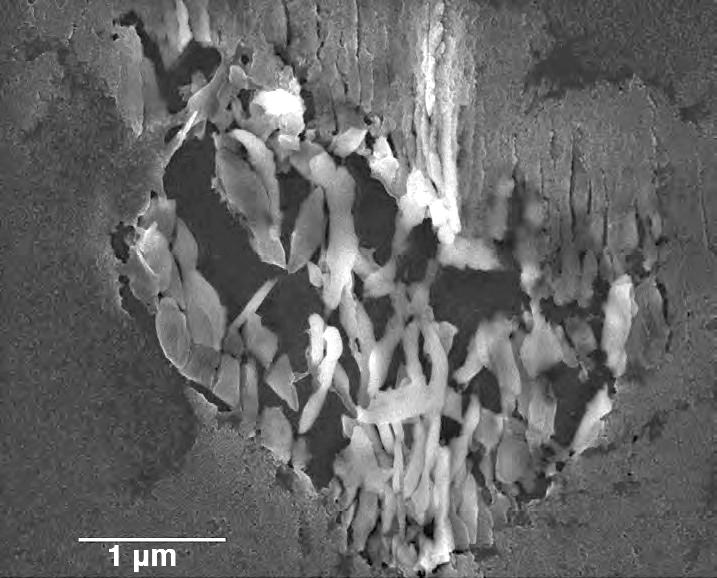
[/caption]
One of the most surprising results from the Stardust mission – which returned comet dust samples to Earth in 2006 – is that comets don’t just consist of particles from the icy parts of the outer solar system, which was the common assumption, but also includes sooty dust from the hot, inner region close to the Sun. A new study confirms this finding, and also provides the first chronological information from the Wild 2 comet (pronounced like Vilt 2). The find paints a chaotic picture of the early solar system.
Even some of the first looks at the cometary particles returned by Stardust showed that contrary to the popular scientific notion, there was enough mixing in the early solar system to transport material from the sun’s sizzling neighborhood and deposit it in icy deep-space comets. Whether the mixing occurred as a gentle eddy in a stream or more like an artillery blast is still unknown.
“Many people imagined that comets formed in total isolation from the rest of the solar system. We have shown that’s not true,” said Donald Brownlee back in 2006, principal investigator for Stardust.
The new study, conducted by scientists from Lawrence Livermore (Calif.) National Laboratory, shows the dust from comet 81P/Wild 2 has been altered by heating and other processes, which could have only occurred if a transport of space dust took place after the solar system formed some 4.57 billion years ago.
“The mission was expected to provide a unique window into the early solar system,” the team, led by Jennifer Matzel wrote in their paper, “by returning a mix of solar system condensates, amorphous grains from the interstellar medium, and true stardust – crystalline grains originating in distant stars. Initial results, however, indicate that comet Wild 2 instead contains an abundance of high-temperature silicate and oxide minerals analogous to minerals in carbonaceous chondrites.”
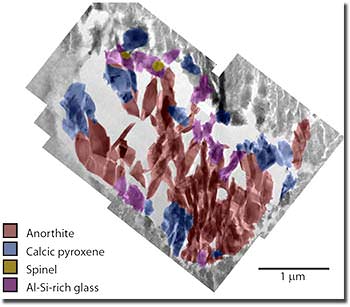
They analyzed a particle from the comet, about five micrometers across, known as Coki. The particle does not appear to contain any of the radiogenic isotope aluminum-26, which implies that this particle crystallized 1.7 million years after the formation of the oldest solar system solids. This means that material from the inner solar system must have traveled to the outer solar system, across a period of at least two million years.
“The inner solar system material in Wild 2 underscores the importance of radial transport of material over large distances in the early solar nebula,” said Matzel. “These findings also raise key questions regarding the timescale of the formation of comets and the relationship between Wild 2 and other primitive solar nebula objects.”
The presence of CAIs in comet Wild 2 indicates that the formation of the solar system included mixing over radial distances much greater than anyone expected.
Sources: LLNL, Astrobiology
WISE Spies Its First Comet
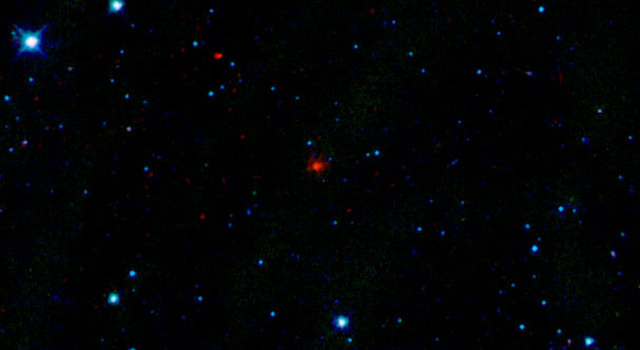
[/caption]
The Wide-field Infrared Survey Explorer or WISE is living up to expectations, as it now has discovered its first comet, shortly after finding its first asteroid. The spacecraft, just launched on Dec. 14, 2009 and first spotted the comet on January 22, 2010. WISE is expected to find millions of other objects during its ongoing survey of the whole sky in infrared light. Officially named “P/2010 B2 (WISE),” the comet is a dusty mass of ice more than 2 kilometers (1.2 miles) in diameter.
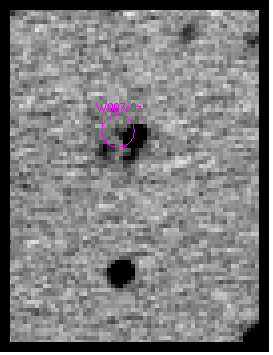
Comet and asteroid hunter Robert Holmes, who we have written about previously on Universe Today (whose Astronomical Research Observatory and Killer Asteroid Project in Illinois is not far from where I live) made the first ground-based confirmation of WISE’s comet discovery, with his home-built 0.81-meter telescope. Many large observatories attempted to confirm this discovery more than 7 days earlier including the Faulkes 2.0m telescope in Hawaii, without success. And due to poor weather, Holmes had to wait several days to get a look at the WISE comet himself. Holmes produces images for educational and public outreach programs like the International Astronomical Search Collaboration (IASC), which gives students and teachers the opportunity to make observations and discoveries, and a teacher actually assisted in the confirmation of this new comet.
Astronomers from the WISE team say the comet probably formed around the same time as our solar system, about 4.5 billion years ago. Comet WISE started out in the cold, dark reaches of our solar system, but after a long history of getting knocked around by the gravitational forces of Jupiter, it settled into an orbit much closer to the sun. Right now, the comet is heading away from the sun and is about 175 million kilometers (109 million miles) from Earth.
“Comets are ancient reservoirs of water. They are one of the few places besides Earth in the inner solar system where water is known to exist,” said Amy Mainzer of NASA’s Jet Propulsion Laboratory in Pasadena, Calif. Mainzer is the principal investigator of NEOWISE, a project to find and catalog new asteroids and comets spotted by WISE (the acronym combines WISE with NEO, the shorthand for near-Earth object).
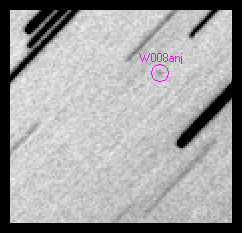
“With WISE, we have a powerful tool to find new comets and learn more about the population as a whole,” said Mainzer. “Water is necessary for life as we know it, and comets can tell us more about how much there is in our solar system.”
“It is very unlikely that a comet will hit Earth,” said James Bauer, a scientist at JPL working on the WISE project, “But, in the rare chance that one did, it could be dangerous. The new discoveries from WISE will give us more precise statistics about the probability of such an event, and how powerful an impact it might yield.”
Comet WISE takes 4.7 years to circle the sun, with its farthest point being about 4 astronomical units away, and its closest point being 1.6 astronomical units (near the orbit of Mars). An astronomical unit is the distance between Earth and the sun. Heat from the sun causes gas and dust to blow off the comet, resulting in a dusty coma, or shell, and a tail.
Sources: JPL, Killer Asteroid Project
Hubble Takes A Look at Possible Asteroid Collision
[/caption]
We reported earlier that on January 6, 2010, ground-based observatories may have spotted evidence of an asteroid collision in the asteroid belt. Now, the Hubble Space Telescope has taken a look at the mysterious X-shaped debris pattern and trailing streamers of dust. With Hubble’s sharp vision, astronomers believe a head-on collision between two asteroids has actually occured. Astronomers have long thought the asteroid belt is being ground down through collisions, but such a smashup has never been seen before.
“This is quite different from the smooth dust envelopes of normal comets,” said principal investigator David Jewitt of the University of California at Los Angeles. “The filaments are made of dust and gravel, presumably recently thrown out of the nucleus. Some are swept back by radiation pressure from sunlight to create straight dust streaks. Embedded in the filaments are co-moving blobs of dust that likely originated from tiny unseen parent bodies.”
Asteroid collisions would likely have an average impact speed of more than 11,000 miles per hour, or five times faster than a rifle bullet. The comet-like object imaged by Hubble, called P/2010 A2, was first discovered by the Lincoln Near-Earth Asteroid Research, or LINEAR, program sky survey on Jan. 6. New Hubble images taken on Jan. 25 and 29 show a complex X-pattern of filamentary structures near the nucleus.
Hubble shows the main nucleus of P/2010 A2 lies outside its own halo of dust. This has never been seen before in a comet-like object. The nucleus is estimated to be 460 feet in diameter.
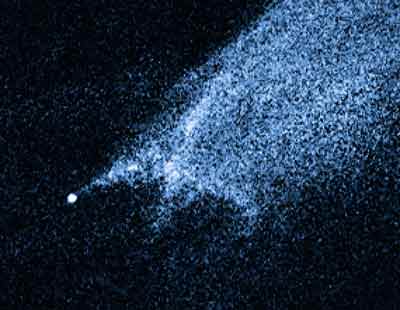
Normal comets fall into the inner regions of the solar system from icy reservoirs in the Kuiper Belt and Oort Cloud. As a comet nears the sun and warms up, ice near the surface vaporizes and ejects material from the solid comet nucleus via jets. But P/2010 A2 may have a different origin. It orbits in the warm, inner regions of the asteroid belt where its nearest neighbors are dry rocky bodies lacking volatile materials.
This leaves open the possibility that the complex debris tail is the result of an impact between two bodies, rather than ice simply melting from a parent body.
“If this interpretation is correct, two small and previously unknown asteroids recently collided, creating a shower of debris that is being swept back into a tail from the collision site by the pressure of sunlight,” Jewitt said.
The main nucleus of P/2010 A2 would be the surviving remnant of this so-called hypervelocity collision.
“The filamentary appearance of P/2010 A2 is different from anything seen in Hubble images of normal comets, consistent with the action of a different process,” Jewitt said. An impact origin also would be consistent with the absence of gas in spectra recorded using ground-based telescopes.
The asteroid belt contains abundant evidence of ancient collisions that have shattered precursor bodies into fragments. The orbit of P/2010 A2 is consistent with membership in the Flora asteroid family, produced by collisional shattering more than 100 million years ago. One fragment of that ancient smashup may have struck Earth 65 million years ago, triggering a mass extinction that wiped out the dinosaurs. But, until now, no such asteroid-asteroid collision has been caught “in the act.”
At the time of the Hubble observations, the object was approximately 180 million miles from the sun and 90 million miles from Earth. The Hubble images were recorded with the new Wide Field Camera 3 (WFC3).
Source: HubbleSite
Asteroid Detection, Deflection Needs More Money, Report Says
Are we ready to act if an asteroid or comet were to pose a threat to our planet? No, says a new report from the National Research Council. Plus, we don’t have the resources in place to detect all the possible dangerous objects out there. The report lays out options NASA could follow to detect more near-Earth objects (NEOs) that could potentially cross Earth’s orbit, and says the $4 million the U.S. spends annually to search for NEOs is insufficient to meet a congressionally mandated requirement to detect NEOs that could threaten Earth. “To do what Congress mandated NASA to do is going to take new technology, bigger telescopes with wider fields,” said Don Yeomans, Manager of NASA’s Near Earth Object Program Office, speaking at the American Geophysical Union conference last month.
However, Yeomans said work is being done to improve the quality and quantity of the search for potentially dangerous asteroids and comets. “We have a long term goal to have three more 1.8 meter telescopes,” he said, “and the Large Synoptic Survey Telescope with an 8.4 meter aperture in 2016. Once these new facilities are in place, the data input will be like drinking from a fire hose, and the rate of warnings will go up by a factor of 40.”
But getting all these facilities, and more, online and running will take continued and additional funding.
Congress mandated in 2005 that NASA discover 90 percent of NEOs whose diameter is 140 meters or greater by 2020, and asked the National Research Council in 2008 to form a committee to determine the optimum approach to doing so. In an interim report released last year, the committee concluded that it was impossible for NASA to meet that goal, since Congress has not appropriated new funds for the survey nor has the administration asked for them.
But this issue isn’t and shouldn’t be strictly left to NASA, said former astronaut Rusty Schweickart, also speaking at the AGU conference. “There’s the geopolitical misconception that NASA is taking care of it,” he said. “They aren’t and this is an international issue.”
Schweickart said making decisions on how to mitigate the threat once a space rock already on the way is too late, and that all the decisions of what will be done, and how, need to be made now. “The real issue here is getting international cooperation, so we can — in a coordinated way — decide what to do and act before it is too late,” he said. “If we procrastinate and argue about this, we’ll argue our way past the point of where it too late and we’ll take the hit.”
But this report deals with NASA, and committee from the NRC lays out two approaches that would allow NASA to complete its goal soon after the 2020 deadline; the approach chosen would depend on the priority policymakers attach to spotting NEOs. If finishing NASA’s survey as close as possible to the original 2020 deadline is considered most important, a mission using a space-based telescope conducted in concert with observations from a suitable ground-based telescope is the best approach, the report says. If conserving costs is deemed most important, the use of a ground-based telescope only is preferable.
The report also recommends that NASA monitor for smaller objects, and recommends that immediate action be taken to ensure the continued operation of the Arecibo Observatory in Puerto Rico, and support a program at the Goldstone Deep Space Communications Complex. Although these facilities cannot discover NEOs, they play an important role in accurately determining the orbits and characterizing the properties of NEOs.
Schweikart quoted Don Yeomans as saying the three most important things about asteroid mitigation is to find them early, find them early and find them early.
“We have the technology today to move an asteroid,” Schweikart said. “We just need time. It doesn’t take a huge spacecraft to do the job of altering an asteroid’s course. It just takes time. And the earlier we could send a spacecraft to either move or hit an asteroid, the less it will cost. We could spend a few hundred million dollars to avoid a $4 billion impact.”
But the report put out by the NRC stresses the methods for asteroid/comet defense are new and still immature. The committee agreed that with sufficient warning, a suite of four types of mitigation is adequate to meet the threat from all NEOs, except the most energetic ones.
• Civil defense (evacuation, sheltering in place, providing emergency infrastructure) is a cost-effective mitigation measure for saving lives from the smallest NEO impact events and is a necessary part of mitigation for larger events.
• “Slow push” or “slow pull” methods use a spacecraft to exert force on the target object to gradually change its orbit to avoid collision with the Earth. This technique is practical only for small NEOs (tens of meters to roughly 100 meters in diameter) or possibly for medium-sized objects (hundreds of meters), but would likely require decades of warning. Of the slow push/pull techniques, the gravity tractor appears to be by far the closest to technological readiness.
• Kinetic methods, which fly a spacecraft into the NEO to change its orbit, could defend against moderately sized objects (many hundreds of meters to 1 kilometer in diameter), but also may require decades of warning time.
• Nuclear explosions are the only current, practical means for dealing with large NEOs (diameters greater than 1 kilometer) or as a backup for smaller ones if other methods were to fail.
Although all of these methods are conceptually valid, none is now ready to implement on short notice, the report says. Civil defense and kinetic impactors are probably the closest to readiness, but even these require additional study prior to reliance on them.

